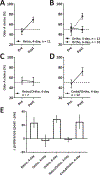Retronasal Odor Perception Requires Taste Cortex, but Orthonasal Does Not
- PMID: 30581018
- PMCID: PMC6604050
- DOI: 10.1016/j.cub.2018.11.011
Retronasal Odor Perception Requires Taste Cortex, but Orthonasal Does Not
Abstract
Smells can arise from a source external to the body and stimulate the olfactory epithelium upon inhalation through the nares (orthonasal olfaction). Alternatively, smells may arise from inside the mouth during consumption, stimulating the epithelium upon exhalation (retronasal olfaction). Both ortho- and retronasal olfaction produce highly salient percepts, but the two percepts have very different behavioral implications. Here, we use optogenetic manipulation in the context of a flavor preference learning paradigm to investigate differences in the neural circuits that process information in these two submodalities of olfaction. Our findings support a view in which retronasal, but not orthonasal, odors share processing circuitry commonly associated with taste. First, our behavioral results reveal that retronasal odors induce rapid preference learning and have a potentiating effect on orthonasal preference learning. Second, we demonstrate that inactivation of the insular gustatory cortex selectively impairs expression of retronasal preferences. Thus, orally sourced (retronasal) olfactory input is processed by a brain region responsible for taste processing, whereas externally sourced (orthonasal) olfactory input is not.
Keywords: flavor; gustatory cortex; learning; multisensory; odor; orthonasal; preference; retronasal; smell; taste.
Copyright © 2018 Elsevier Ltd. All rights reserved.
Conflict of interest statement
Declaration of Interests
The authors declare no competing interests.
Figures



Comment in
-
Gustation and Olfaction: The Importance of Place and Time.Curr Biol. 2019 Jan 7;29(1):R18-R20. doi: 10.1016/j.cub.2018.11.038. Curr Biol. 2019. PMID: 30620909 Free PMC article.
References
-
- Rozin P (1982). “Taste-smell confusions” and the duality of the olfactory sense. Percept Psychophys 31, 397–401. - PubMed
-
- Gibson JJ (1966). The senses considered as perceptual systems, (Oxford, England: Houghton Mifflin; ).
-
- Chapuis J, Messaoudi B, Ferreira G, and Ravel N (2007). Importance of retronasal and orthonasal olfaction for odor aversion memory in rats. Behav Neurosci 121, 1383–1392. - PubMed
-
- Chapuis J, Garcia S, Messaoudi B, Thevenet M, Ferreira G, Gervais R, and Ravel N (2009). The way an odor is experienced during aversive conditioning determines the extent of the network recruited during retrieval: a multisite electrophysiological study in rats. J Neurosci 29, 10287–10298. - PMC - PubMed
-
- Small DM, Gerber JC, Mak YE, and Hummel T (2005). Differential neural responses evoked by orthonasal versus retronasal odorant perception in humans. Neuron 47, 593–605. - PubMed
Publication types
MeSH terms
Grants and funding
LinkOut - more resources
Full Text Sources

